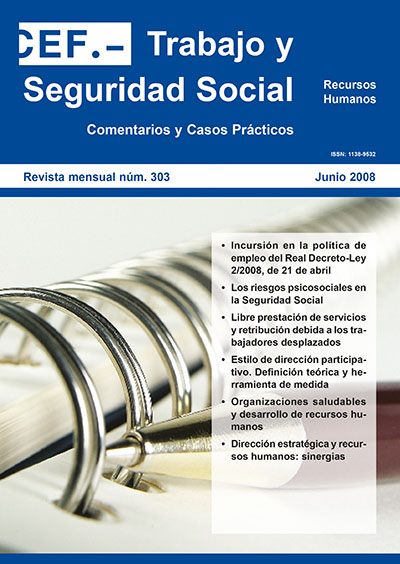Dirección estratégica y recursos humanos: sinergias
DOI:
https://doi.org/10.51302/rtss.2008.5583Keywords:
capital humano, recursos humanos, ventaja competitivaAbstract
En este artículo analizaremos los puntos de intersección entre la gestión de recursos humanos y la dirección estratégica así como los retos futuros de las empresas en estas áreas. La dirección estratégica, y, en particular, la teoría de los recursos y capacidades ofrece un marco conceptual para el análisis de los recursos estratégicos organizativos que sin duda puede ser aplicado al análisis de los recursos humanos.
Downloads
References
Amit, R. y Schoemaker, P.J.H. [1993]: «Strategic assets and organizational rent», Strategic Management Journal, Vol. 14, págs. 33-46.
Barney, J. [1991]: «Firm resources and sustained competitive advantage», Journal of Management, vol. 17 (1), págs. 99-120.
Becker, G. [1964]: Human capital, Columbia University Press, New York.
Dierick, I. y Cool, K. [1989]: «Assets stock accumulation and sustainabilty of competitive advantage», Management Science, Vol. 35, págs. 1.504-1.511.
Itami, H. [1987]: Mobilizing invisible assets, Harvard Business School Press.
Lepak, D. P. y Snell, S. A. [1999]: «The human resource architecture: Toward a theory of human capital allocation and development», Academy of Management Review, Vol. 24, págs. 31-48.
Lippman, S. y Rumelt, R.P. [1992]: «Uncertain imitability: An analysis of interfirm differences in efficiency under competition», Bell Journal of Economics, Vol. 13; págs. 418-453.
Nelson, R. y Winter, S. [1982]: An evolutionary theory of economic change, Harvard University Press.
Ordóñez de Pablos, P. [2001]: Capital intelectual, gestión del conocimiento y sistemas de gestión de recursos humanos: Influencia sobre los resultados organizativos. Tesis Doctoral, Universidad de Oviedo.
– [2004]: «A guideline for building the intellectual capital statement: the 3R Model», International Journal of Learning and Intellectual Capital, Vol. 1, N.º 1, págs. 3-18.
– [2004]: «Gestión de recursos humanos y gestión del conocimiento: La alineación estratégica como clave para la competitividad empresarial». Revista de Trabajo y Seguridad Social. CEF. Número 260. Núm. 57/2004. Noviembre. Págs 115-146.
Ordóñez De Pablos, P., Peteraf, M.A., and Ventura, J. [2007], «Foreword: the resource-based theory of the firm – challenges, new and old «, International Journal of Learning and Intellectual Capital, Vol. 4, N.º 1-2, págs.1-10.
Penrose, E.T [1959]: The theory of the growth of the firm, John Wiley & Sons, New York, NY.
Peteraf, M.A. [1993]: «The cornerstone of competitive advantage: A resource based-view», Strategic Management Journal, Vol. 14, págs. 179-191.
Reed, R. y DeFillippi, R. [1990]: «Causal ambiguity, barriers to imitation and sustainable competitive advantage», Academy of Management Review, Vol. 15 (1), págs. 88-102.
Rumelt, R.P. [1984]: «Towards a strategic theory of the firm», en Lamb, R.B. (ed.), Competitive Strategic Management. Prentice-Hall, Englewood Cliffs, NJ, págs. 556-570.
Snell, S.A. y Youndt, M.A. [1995]: «Human resource management and firm performance: Testing a contingency model of executive controls», Journal of Management, 21 (4), 711-737.
Snell, S. A., Lepak, D.P. y Youndt, M.A. [1999]: «Managing the architecture of intellectual capital: Implications for strategic human resource management», en G. R. Ferris (Ed.): Research in Personnel and Human Resources.
Ventura Victoria, J. y Ordóñez de Pablos, P. (Coord.) [2003]: Capital intelectual y aprendizaje organizativo: Nuevos desafíos para la empresa. AENOR.
Wernerfelt, B. [1984]: «A resource based view of the firm», Strategic Management Journal, Vol. 5, págs. 171-180.
Williamson, O.E. [1975]: Markets and hierarchies. New York: Free Press.
Wright, P.M. y McMahan, G.C. [1992]: «Theoretical perspectives for strategic human resource management», Journal of Management, Vol. 18, N.º 2, págs. 295-320.
Wright, P. M., McMahan, G.C. y McWilliams, A. [1994]: «Human resources and sustained competitive advantage: A resource-based perspective», International Journal of Human Resource Management, 5 (2), 301-326.


















